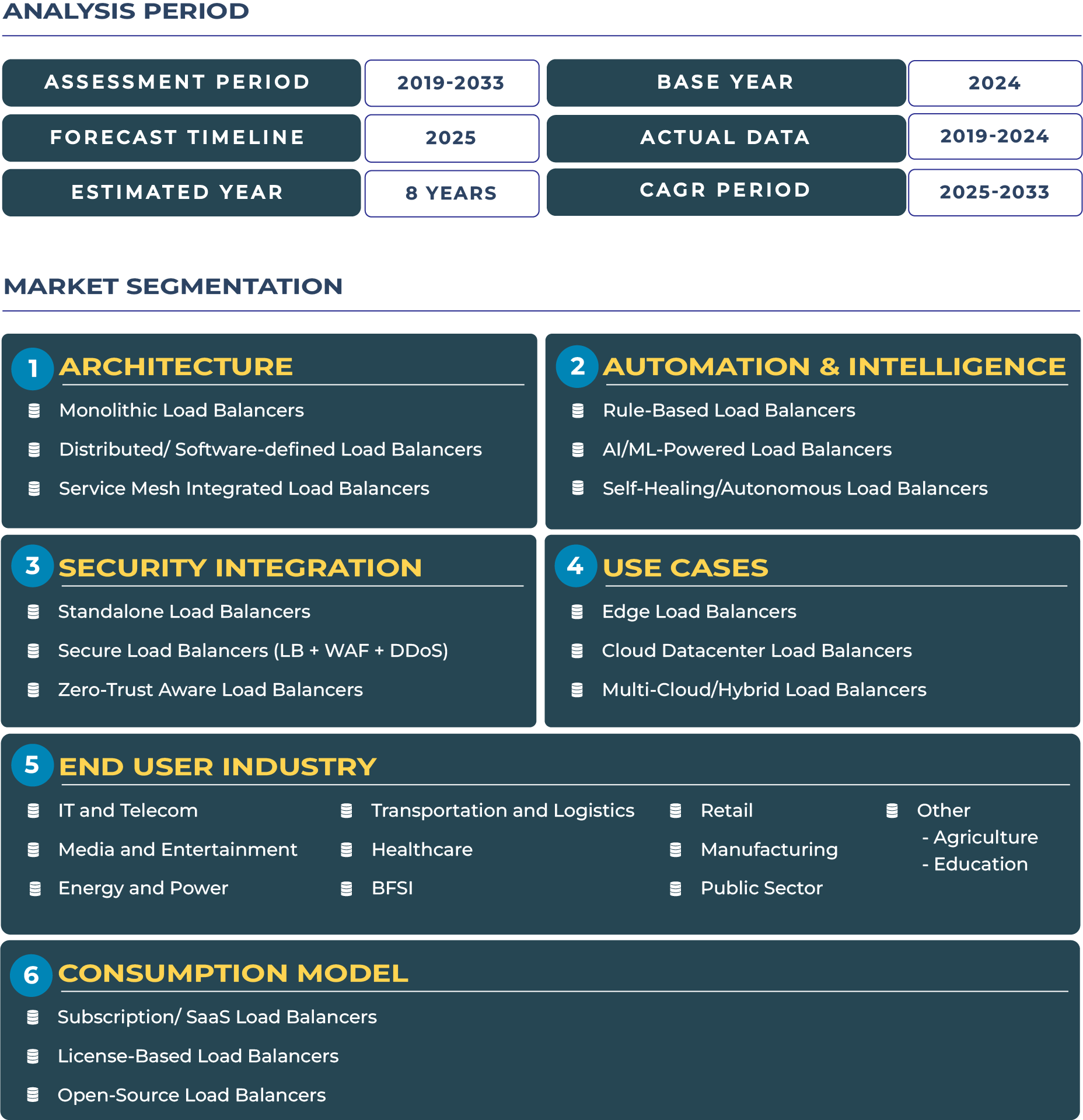Report Format:
![]()
![]() |
Pages: 160+
|
Pages: 160+
Europe Cloud Load Balancers Market: Balancing Unified Policies with Diverse National Adoption
Europe is positioning itself as a region that balances unified digital policies with diverse national adoption patterns. This dynamic is particularly visible in the cloud load balancers market, where regulatory harmonization by the European Union meets varying enterprise modernization strategies across member states. As of 2025, the Europe Cloud Load Balancers Market is estimated at USD 985.2 million and is projected to reach USD 3,204.2 million by 2033, expanding at a CAGR of 15.9%. This trajectory reflects strong digital sovereignty initiatives, demand for compliance-driven architectures, and increasing enterprise reliance on secure, efficient traffic distribution across cloud environments.
Market Outlook: Why Europe Cloud Load Balancers Market Is Poised for Scalable Growth
The market outlook for Europe is strongly influenced by political will, regulatory clarity, and the rapid pace of digitalization across sectors such as banking, healthcare, and public services. The expansion of hyperscalers in Germany, Spain, and the Nordics, alongside sovereign cloud strategies, underpins demand for distributed and software-defined load balancing solutions. Despite geopolitical uncertainties and the lingering impacts of energy costs across data centers, enterprises are prioritizing investments in resilient cloud infrastructure. The forecasted growth underscores how EU-wide harmonization—when aligned with localized digital adoption strategies—creates a robust environment for cloud load balancer adoption.
Drivers & Restraints: Navigating Digital Acceleration and Compliance Burdens
Drivers fueling Europe’s growth: A central driver of this market is the EU’s Digital Strategy, which promotes cross-border integration and secure digital ecosystems. Expansion of hyperscalers such as AWS and Microsoft Azure into multiple European cities enhances enterprise reliance on load balancers for distributed application performance. Additionally, the BFSI and healthcare industries are integrating cloud-native systems, where load balancers ensure compliance, security, and performance in highly sensitive environments.
Restraints challenging progress: On the other hand, compliance remains costly. The stringent implementation of the General Data Protection Regulation (GDPR) elevates operational expenses for cloud players. Fragmented interpretations of EU-wide policies at the national level create regulatory complexity, particularly for SMEs. Moreover, high energy costs in Europe’s data centers continue to affect operating margins, potentially slowing infrastructure investment. These barriers underscore the balancing act between fostering innovation and maintaining compliance.
Trends & Opportunities: Sovereign Clouds, Multi-Cloud Adoption, and AI-Driven Orchestration
Trends shaping the landscape: Europe’s sovereign cloud initiatives, such as the GAIA-X project, are redefining how enterprises approach cloud load balancing, emphasizing transparency, compliance, and data sovereignty. Multi-cloud adoption has become a dominant strategy, enabling organizations to avoid vendor lock-in while enhancing resiliency. AI-driven orchestration within service mesh integrated load balancers is another notable trend, delivering predictive scaling, anomaly detection, and optimized resource use across hybrid environments.
Opportunities driving investment: Opportunities are particularly strong for sovereign cloud providers offering GDPR-aligned solutions. Public sector contracts, particularly in healthcare and education, present a lucrative path for expanding the use of distributed and software-defined load balancers. The rise of AI and advanced analytics services also amplifies the demand for intelligent traffic management, ensuring that European enterprises remain competitive in an increasingly digital-first global economy.
Regional Analysis
Western Europe Cloud Load Balancers Market
The Western Europe Cloud Load Balancers Market is witnessing robust growth, driven by the presence of digital-first economies such as Germany, France, and the UK. Strong EU regulations on data protection and sovereignty, alongside high enterprise cloud adoption in BFSI and healthcare, are fueling demand for software-defined and distributed load balancing solutions. The expansion of hyperscalers’ regional data centers further accelerates modernization strategies. However, energy costs and fragmented interpretations of GDPR at national levels present operational challenges. Despite these restraints, the market is projected to expand steadily as enterprises prioritize secure and compliant multi-cloud strategies for sustainable digital transformation.
Eastern Europe Cloud Load Balancers Market
The Eastern Europe Cloud Load Balancers Market is growing as enterprises transition from legacy infrastructure to hybrid and cloud-native environments. Countries like Poland and Russia are investing in digital infrastructure, with government-backed programs encouraging local cloud adoption. Demand for cost-efficient distributed load balancers is rising, particularly in manufacturing and telecom sectors. However, geopolitical tensions and regulatory uncertainties in parts of the region pose risks to seamless adoption. Energy dependence also influences the operating cost of data centers. Nevertheless, the market presents opportunities through public-private partnerships and increasing interest in sovereign cloud solutions tailored for regional compliance and security needs.
Competitive Landscape: Sovereign Strategies and Infrastructure Expansion Define the Market
The competitive landscape is marked by both regional leaders and global players shaping Europe’s digital ecosystem. OVHcloud has expanded sovereign offerings in 2024 to align with GDPR and local data hosting rules. Global hyperscalers are also reinforcing their presence—AWS announced new data center investments in Germany and Spain in 2024 to strengthen regional compliance offerings. Meanwhile, the GAIA-X project continues to expand (2023), anchoring Europe’s push toward digital sovereignty. These moves demonstrate a clear focus on sovereign plus hybrid solutions, bridging the gap between regulatory demands and enterprise modernization goals. Competitive strategies are increasingly oriented around building trust, enabling localization, and integrating advanced load balancing solutions into diversified cloud ecosystems.








